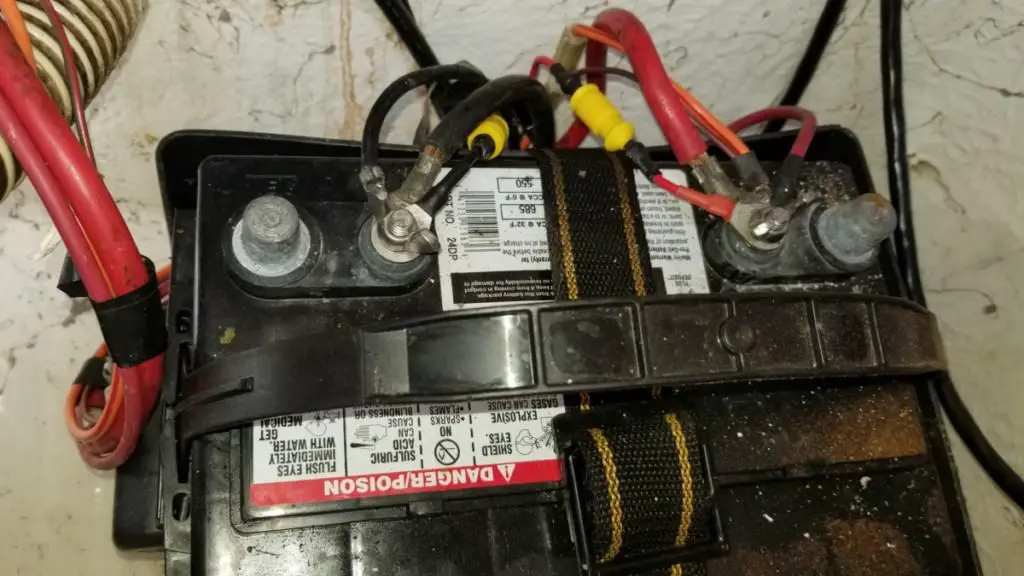If you’re new to boating or stepped on a friends boat for the first time, you might have found yourself wondering why there are so many batteries onboard but didn’t ask to keep your cool. Maybe you were an another similar sized boat and only saw one battery instead of two or three (or more).
It’s a good question and it mostly comes down to the energy requirements of the user, their preferences, and their habits.
A boat typically has 2 or 3 batteries (or more) to serve as separate “house” and “starter” batteries. A designated starter battery (or dual-purpose) is used to start the boat’s engine. A deep-cycle battery (or more) and is used for all other battery operated needs when on the water.
Starter Batteries on a Boat
All boats with an engine will have a starter battery. It may be a designated starter battery or a dual purpose battery which is a happy medium between a true starter battery and a deep-cycle.
The purpose of the starter battery is to be repeatedly used to start the boat’s engine throughout your boating journey.
Based on its internal construction, a true starter battery is not meant for deep-cycle applications, is actually damaged by the process, and will have a very short life if used that way.
Starter batteries have very thin lead plates inside with lots of surface area and the plates are very close to each other. All of these features allows for a large but short (relatively speaking) surge of amperage to be released in order to fire up your boat’s engine.
When discharged to any significant level, starter batteries will begin to rapidly build up lead sulfate on the plates which is a natural process when the battery is not in a full state of charge. This lead sulfate covers the plates and crystallizes. This acts as a barrier to charging and discharging and makes it increasingly harder for the battery accept and give away a charge.
If the lead sulfate builds up enough, it can even bridge the gap between the plates and cause an internal short which will kill that particular cell. Any lead sulfate that becomes dislodged will sink to the bottom in the sediment catch and when that builds up high enough (with all the rocking from the boat) it can also bridge the gap at the bottom of the plates and kill the battery.

Because this sulfation occurs quickly when not full charged and is relatively permanent, it makes starter batteries a poor choice for running a trolling motor, a DC mini fridge, a fan, etc.
If you’ve got a smaller boat, you only spend a few hours on the water, and you don’t overdue anything with battery needs, then you can absolutely get away with a dual purpose battery.
It packs less of a punch than a starter battery when it comes to starting engines, but it is far superior to deep-cycle batteries for that purpose. Considering how few people actually boat in very cold weather, they are generally more than enough for starting purposes.
They also don’t deteriorate internally nearly as quickly as a starter battery, but they lack the endurance and longevity of a true deep-cycle.
House Batteries on a Boat
House boat batteries will generally be marine deep-cycle or even golf cart batteries which are also rugged and deep-cycle.
These are the marathon runner in the battery world and are meant to power your battery needs for the long-haul. You can even take them down to a state of full discharge (though it is best to stop before you hit 50% if you want to maximize the lifespan of your batteries).
A starter battery could only be discharged fully about 10-12 times before it would cease working. A deep-cycle battery can be fully discharged about 175 times before it dies. A starter battery can be discharged 30% about 175 times, whereas a deep-cycle battery can be cycled down 30% for over 1,000 times.
The difference between the two is pretty clear.
Internally, a deep-cycle battery has thicker plates (to absorb more energy), less surface area, and the plates are spaced more than a starter battery. This allows for low to medium amperages over a long period of time.
The also have a protective alloy on the plates which allows for lead sulfate to be more easily removed and reconverted through the recharge process.
Multiple Battery Banks
Some boats will even have two or more “house” batteries or banks. This could happen with larger boats and where the banks will be structured and placed in a way to reduce voltage drop. Batteries in the back might power items in the back, and batteries in the front would take care of things near the bow.
Voltage drop occurs naturally as you stretch more and more wires and cables to reach your desired appliance from the battery and all of the wires coming back to the battery to complete the circuit. The longer the line, the less voltage reaches it. If the voltage drop is significant enough, it may damage what you’re trying to power or it may not run at all.
There could also be a separate battery for things like a battery-powered windlass on the front of the boat which raises and lowers a heavy anchor.
Charging Multiple Batteries
If you have the right devices, you can certainly charge all of your batteries with a single charging setup.
With shore power, you’ll need a charger that can support the number of banks that you have.
This charger from Amazon can handle up to 4 separate banks. It has a solid 5 star rating with over 250 reviews, can handle 12/24/36/48-volt systems, and can charge up to 4 battery banks (regardless of the battery type). There are models as well on the same link that are 1, 2, or 3 bank chargers.
A quality charger like the one above isolates each bank but can charge them simultaneously. You could have a flooded deep-cycle battery on one, and an AGM on another.

If you are looking to charge multiple batteries with the alternator, there are so many variables that go into it depending on your budget and how often and how long you boat.
Generally, if you can manage it, I would recommend looking into an external regulator with temperature sensors for both the alternator and the batteries.
It’s also a good idea to have an alternator that can produce quite a bit more charging current than you’ll need and then you can simply dial back the regulator to charge appropriately.
Keeping your alternator from having to work at 100% capacity will keep you from repeatedly burning it out — especially if you have AGM batteries.
